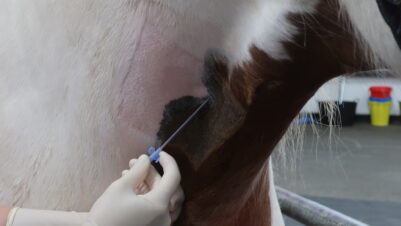Being an equine registered veterinary nurse (eRVN) is dynamic, demanding and rewarding. The eRVN profession is still fairly new, with the first equine veterinary nurses qualifying in the year 2000. However, there has been a lot of change since then, most notably the introduction of the Royal Charter in 2015 and statutory regulation of RVNs by the Royal College of Veterinary Surgeons (RCVS).
This article will explore Schedule 3 of the Veterinary Surgeons Act 1966 and how this can be applied to facilitate the correct utilisation of equine RVNs in practice.
Struggles facing eRVNs in practice
eRVNs have, in the past, felt overlooked or forgotten due to low numbers and minimal exposure. Lack of clarity surrounding Schedule 3 of the Veterinary Surgeons Act 1966 is also a significant problem, as it causes veterinary surgeons to be reluctant to delegate appropriate tasks to eRVNs. This reduces the efficiency of the veterinary team and contributes to the lack of career progression that is currently apparent in this industry, which in turn contributes significantly to the current retention crisis.
The majority of eRVNs want to take on more responsibility in terms of Schedule 3 procedures; they just need the opportunity and support from their practices to do so
Furthermore, eRVNs struggle to prove their value financially in practice, and this leads to frustration and, ultimately, skilled individuals leaving the profession. The majority of eRVNs want to take on more responsibility in terms of Schedule 3 procedures; they just need the opportunity and support from their practices to do so. To assist with this, the British Equine Veterinary Association (BEVA) has produced a set of guidelines to help with the interpretation of Schedule 3, with a view to instill confidence in veterinary surgeons to delegate more procedures to eRVNs in practice.
The Veterinary Surgeons Act 1966 (Schedule 3 Amendment) Order 2002
As discussed in the BEVA Schedule 3 guidelines, the Veterinary Surgeons Act 1966 (Schedule 3 Amendment) Order 2002 lays out what eRVNs and equine student veterinary nurses (eSVNs) can do in practice. It provides that veterinary surgeons may direct registered or student veterinary nurses who they employ to carry out limited veterinary surgery. Under this Schedule 3 exemption, the privilege of giving any medical treatment or carrying out minor surgery not involving entry into a body cavity is given to:
- Registered veterinary nurses under the direction of their employer to animals under their employer’s care. The directing veterinary surgeon must be satisfied that the veterinary nurse is qualified to carry out the medical treatment or minor surgery
- Student veterinary nurses under the direction of their employer to animals under their employer’s care. In addition, medical treatment or minor surgery must be supervised by a veterinary surgeon or RVN, and in the case of minor surgery, the supervision must be direct, continuous and personal. The medical treatment or minor surgery must be carried out in the course of the SVN’s training (RCVS, 2024)
The RCVS has interpreted these terms as follows:
- “Direction” means that the veterinary surgeon instructs the RVN or SVN on the tasks to be performed but is not necessarily present
- “Supervision” means that the veterinary surgeon or RVN is present on the premises and able to respond to a request for assistance if needed
- “Direct, continuous and personal supervision” means that the veterinary surgeon or RVN is present and giving the SVN their undivided personal attention (RCVS, 2024)
| Did you know we offer CPD membership plans? Get access to thousands more articles, hundreds of short courses and easily fulfil your annual CPD requirements. Find out more here. |
Permitted Schedule 3 procedures
Veterinary surgeons are advised to always consider legislation, professional guidance and the scope of competence of the eRVN or eSVN before directing them to carry out any procedure under Schedule 3

Below is a list of Schedule 3 procedures that have been deemed suitable to be delegated to eRVNs. This list is not exhaustive, and veterinary surgeons are advised to always consider legislation, professional guidance and the scope of competence of the eRVN or eSVN before directing them to carry out any procedure under Schedule 3 (BEVA, 2024).
eRVN or eSVN permitted acts (under the direction or supervision of a veterinary surgeon as per Schedule 3) (BEVA, 2024):
- Administration of medication, including via intravenous (Figure 1), intramuscular, subcutaneous, oral and topical routes
- Intravenous catheterisation (Figure 2)
- Phlebotomy (taking of blood samples)
- Radiography, computed tomography, scintigraphy and magnetic resonance imaging (acquiring images, not diagnosing pathology) where appropriate training has been completed
- Wound assessment, dressing and bandaging (Figure 3)
- Suturing and repair of superficial wounds where appropriate training has been completed
- Perineural analgesia where appropriate training has been completed
- Passing a nasogastric tube for the administration of fluids/feed or retrieval of reflux
- Placing an endotracheal or nasotracheal tube to maintain a patent airway
- Euthanasia where there is a veterinary surgeon on the premises and appropriate training has been completed
- Administration of sedation and maintenance of anaesthesia following an agreed individual protocol which has been discussed beforehand with the case veterinary surgeon
- Vaccination (second and subsequent vaccinations) where appropriate training has been completed; eRVNs are not permitted to certify vaccinations
Readers are encouraged to read the “How to implement the guidance” section on the BEVA website, which contains further guidance for each skill, including any Schedule 3 considerations and requirements for additional training.

A look to the future under Schedule 3
Further development is also possible, with a growing role in ambulatory nursing and client care coming to light and being supported by several practices

Gaining clarity surrounding Schedule 3 of the Veterinary Surgeons Act 1966 will help to develop the role of the eRVN and encourage better utilisation of them in practice.
A good way to start conversations around this is to run a practice meeting where everyone can share ideas and examples. Schedule 3 can be discussed along with the considerations for delegation from vets to RVNs and the benefits of this to the practice and the patients. Using a collaborative approach will enable long-term solutions that are positive for all involved to be reached.
Further development is also possible, with a growing role in ambulatory nursing and client care coming to light and being supported by several practices. The ambulatory nursing role facilitates closer contact with clients and the patients themselves, which will help eRVNs increase public awareness of their role.
Client trust and respect must be gained for clients to embrace and appreciate the skills and expertise being offered by eRVNs. This will benefit equine patients enormously and contribute to job satisfaction and retention for eRVNs in the long run.
Client trust and respect must be gained for clients to embrace and appreciate the skills and expertise being offered by eRVNs
Final thoughts
eRVNs are keen to work hard to bring about a positive transition within equine veterinary practice. If the utilisation of eRVNs is encouraged and implemented it will lead to better staff retention, increased team efficiency and, importantly, higher standards of patient care.











